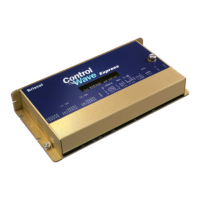
Do you have a question about the Emerson ControlWave EFM 3808 and is the answer not in the manual?
| Brand | Emerson |
|---|---|
| Model | ControlWave EFM 3808 |
| Category | Automobile Parts |
| Language | English |
Details the physical components of the ControlWave Express, including its enclosure, boards, and optional display.
Describes the CPU/System Controller board, its microprocessor, memory, and communication ports.
Outlines the three basic variations of the CPU/System Controller board based on CPU, power, and I/O capabilities.
Explains the different methods for powering the ControlWave Express, including solar, battery, and bulk power supplies.
Lists the standard I/O features and the available optional process I/O board configurations.
Details the software tools used for programming the ControlWave Express, including ControlWave Designer and OpenBSI Utilities.
Provides guidance on selecting an appropriate installation site and ensuring clearances for wiring and service.
Outlines specific requirements for installing the ControlWave Express in hazardous locations according to NEC standards.
Details the general steps involved in installing the ControlWave Express hardware and software.
Explains the procedure for properly grounding the ControlWave Express enclosure for safety.
Provides instructions for setting switches and jumpers on the CPU/System Controller board for configuration.
Details the function and settings for DIP switches SW1, SW2, and SW3 on the CPU/System Controller board.
Explains the configuration options for various jumpers (W1-W18) on the CPU/System Controller board.
Offers best practices for making terminal connections and wiring the ControlWave Express.
Provides detailed instructions for connecting power to the CPU/System Controller board using terminal blocks TB1 and TB2.
Details how to connect to the RS-232 serial ports (COM1, COM2) using different connector types.
Explains configuration and wiring for the COM3 port, supporting both RS-232 and RS-485 protocols.
Describes how to connect to the 10/100Base-T Ethernet port for network communication.
Details the available optional keypads and displays for the ControlWave Express.
Lists the standard I/O capabilities and the configurations of optional process I/O boards.
Covers the configuration of the optional Process I/O board using jumpers and DIP switches.
Details the function and settings for jumpers (JP1, JP3-JP7) on the Process I/O board.
Explains the configuration options for DIP switch SW1 on the Process I/O board.
Provides guidance on wiring I/O connections to the ControlWave Express, including shielding and grounding.
Describes the characteristics and wiring of non-isolated discrete inputs on TB2 and TB3.
Details the characteristics and wiring of non-isolated discrete outputs on TB3.
Explains the configuration and wiring for non-isolated analog inputs on TB6.
Covers the configuration and wiring for the non-isolated analog output on TB7.
Describes the pulse counter/discrete inputs on TB5 of the CPU/System Controller board.
Details the high speed counter and discrete inputs on TB4 of the Process I/O board.
Explains how to connect and wire a 3-wire RTD to the CPU/System Controller board.
Provides wiring diagrams for connecting a Bristol 3808 transmitter via RS-232 and RS-485.
Guides the user through the procedures for applying and removing power to the ControlWave Express.
Explains how to establish communication between a PC and the ControlWave Express.
Lists the factory default communication port settings for COM1, COM2, COM3, and Ethernet.
Describes how to use OpenBSI utilities to collect real-time and historical data.
Outlines the process of creating and downloading a ControlWave project using ControlWave Designer software.
Emphasizes the importance of backing up ControlWave projects and configuration parameters.
Provides step-by-step instructions for creating a complete backup of a ControlWave project.
Explains how to save the ControlWave Express's flash configuration parameters using the Flash Configuration utility.
Describes methods for backing up different types of data, such as tuning parameters and data arrays.
Details methods for upgrading the ControlWave Express system firmware using various utilities.
Provides procedures for accessing and replacing hardware components like boards and batteries.
Step-by-step guide for removing and replacing the main CPU and optional Process I/O boards.
Instructions for safely removing and replacing the CPU/System Controller board's backup battery.
Offers general guidance for troubleshooting issues with the ControlWave Express.
Explains the function of the LEDs on the ControlWave Express for diagnostic purposes.
Details how to use the WINDIAG software for testing system components like I/O and memory.
Lists the diagnostic tests available within the WINDIAG utility for various components.
Explains how to perform a core updump to upload system memory contents for troubleshooting.
Provides crucial safety and wiring instructions for installing the RTU in hazardous environments.
Lists all customer wiring connectors for modules and boards with their associated wiring notes.